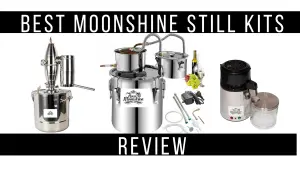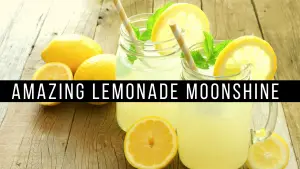Moonshine can be made with very few ingredients-even without yeast. Check out our moonshine recipe without yeast.
Moonshine recipes come in a variety of sizes with many different types of ingredients. In general, most moonshiners are aware you can make moonshine from grain, fruit or sugar. However, most may not realize you can actually make moonshine without yeast.
Making moonshine is a three-step process that takes a few weeks to complete. This means if you really want to try moonshine and make it yourself you better be patient!
While the process isn’t super speedy, it is really satisfying. Not only are you able to make your own spirits from the comforts of home, but there are endless recipes at your fingertips to make different varieties of moonshine as well as different cocktails that include moonshine.
It’s no wonder moonshining is growing in popularity so quickly. With so many people wanting to live more independently and off-grid, moonshine is a great option to get delicious tasting spirits without a bloated price tag.
Moonshine is also a great spirit to give to friends and family as well as serve at special events. Gone are the days when moonshine was associated with a harsh tasting liquor. Today’s moonshine has a variety for every palate!
The Role of Yeast in a Moonshine Mash
Yeast plays an important role in the production of moonshine. In fact, you could say yeast is the star of the fermentation stage of moonshining. This is because yeast is what actually turns the fermentable sugars in your moonshine mash into alcohol and carbon dioxide.
Since yeast plays such an important role in the production of moonshine, it seems odd that you can make moonshine without it. The truth is, you can’t.
You can make moonshine without adding additional yeast. However, yeast is actually a living micro fungus that lives in the air. Under the correct conditions, your alcohol can ferment without adding yeast and using only natural occurring yeast and bacteria.
What Does Yeast Tell Us About Fermentation?
When fermenting alcohol is obviously our end goal. However, the carbon dioxide produced by yeast during fermentation is also important. As your mash ferments, carbon dioxide will be released and bubbles will float to the surface of your fermentation bucket.
These bubbles tell us a lot about what is going on with your moonshine. If your mash fails to bubble or stops bubbling early it is a sign there is something wrong with the mash.
Even if your fermentation bucket is covered and not clear, you can tell if your mash is bubbling with an airlock.
With this in mind, it is apparent yeast is an important ingredient in moonshine. But can you make moonshine without yeast? The answer is yes!
Why Would You Make Moonshine Without Yeast?
Many may be asking themselves, ‘what is the point of making moonshine without yeast?’ There are actually quite a few reasons to try to make a batch of moonshine using this method.
The first and foremost is to make moonshine the traditional way. Many want to preserve the methods that were developed by early Americans to make white whiskey.
Early moonshiners were not able to simply purchase yeast to make their mash process easier. They had to rely on natural yeasts in order to ferment.
In addition to maintaining tradition, many swear that moonshine made without yeast tastes better, smells better and leaves less of a hangover. However, others warn that natural yeast is a much slower process that results in a much lower alcohol by volume.
How to Make Moonshine Without Yeast
Making moonshine without yeast can be done and many would argue the method is actually very simple.
When making moonshine with yeast, there are many different options of yeast at your fingertips. Some, such as Turbo Yeast, can speed up the fermentation process.
When you make a moonshine mash without yeast the process is much more simple, but you have less control. There is no magical ingredient to speed the process up. You need to go back to basics and have a little patience. However, your efforts will be well worth it!
Making moonshine without yeast is not simple. In fact, it would be much simpler to make wine since many fruits, such as grapes, are covered in natural yeast which will easily lend itself to this type of fermentation method.
In order to ferment fruit, you would simply crush or smash the fruit (the same way you would do in any fruit mash recipe) and place in an airtight container with a lid. Of course, because you are relying on wild yeast for fermentation, you cannot wash the fruit before adding them to the mash.
How to Make a Wild Yeast Starter
Do you want to use yeast in your moonshine that you know will not taint your final product? Many swear by making their own ‘wild yeast starter’ instead of purchasing commercial products.
This type of starter uses the natural yeast that is found on many wild fruits. Some great options are juniper berries, elderberries, wild grapes, blueberries, or figs. Again, wild fruits that are foraged are what is needed for this recipe.
- Once you have gathered your fruit, make a simple sugar solution of ¼ sugar to ¾ water.
- Use a sterilized fermentation jar or airtight jar. Add your fruit and sugar water.
- Put your jar in a warm dark place. Shake 3 to 4 times daily. After about 5 days you will see your solution is bubbly and ready to be added in the place of a traditional yeast.
Make sure to smell the yeast before using. If it smells bad, do not use it!
The Right Equipment for the Job
While fermentation plays an important role in making moonshine, it takes a backseat to distillation. Distillation is the process in which you use heat to separate the ethanol from the water in your mash.
The right still can arguably make or break a run. This is because using top quality stills has a big impact on the taste, quality and ABV of your final product.
At How to Moonshine, we believe that good quality stills don’t need to cost a fortune. Our moonshine still kits are made to be user friendly while still producing a quality product.
Our Magnum Moonshine Still Kit is not only our biggest kit yet, but it also has some premium features that set it apart from the crowd.
- The Magnum’s fermenter, condenser keg, and rectifying tower are all constructed with food-grade stainless steel material. This means your Magnum All-in-One Still Kit will be durable, sturdy, and easy to clean.
- The Magnum is our biggest still yet! The large capacity of the pot is perfect for even the largest recipes.





